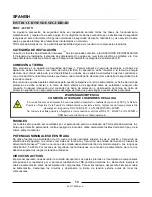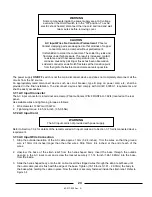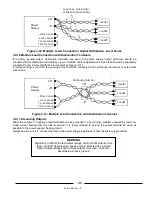
83-517-000 Rev.
A
27
3. Wait a few seconds until the
VOLTAGE
meter returns to display the Output voltage.
4. Adjust the Output voltage toward its minimum value and check that the Output voltage cannot be decreased
below the
UVL
setting.
5. Adjust the
UVL
limit to the minimum by repeating Step 1 and rotating the
VOLTAGE
encoder CCW.
Foldback Check
3.8.7
Refer to Section 5.5 for explanation of the
FOLD
function prior to performing the procedure below.
1. Ensure that the Output Voltage is set to approxiamtely 10% of the unit Output voltage rating.
2. Adjust the
CURRENT
encoder to set the current limit to approximately 10% of the unit Output current rating.
3. Momentarily press the
FOLD
button. Ensure that the
FOLD
LED illuminates. The Output voltage remains
unchanged.
4. Momentarily place a short-circuit across the the Output terminals (approximately 0.5 seconds). Ensure that
the Output Voltage falls to zero, the
VOLTAGE
meter displays
“
Fb
” and the
ALARM
LED blinks.
5. Press the
FOLD
button again to cancel the
FOLD
back protection. The Output voltage should still remain at
zero.
6. Press the
OUT
button. Ensure that the Output voltage returns to its last setting.
7. Turn the output off by pressing the
OUT
button. Ensure that the
VOLTAGE
meter displays
“
OFF
”.
Address Setting
3.8.8
1. Press and hold the
REM/LOC
button for approximately 3 seconds. The
VOLTAGE
meter will display the
communication port address.
2. Using the
VOLTAGE
adjust encoder; check that the unit address can be set within the range of 0 to 30.
Baud Rate Setting (RS-232 and RS-485 only)
3.8.9
1. Press and hold the
REM/LOC
button for approximately 3 seconds. The
CURRENT
display will show the
communication port Baud rate.
2. Using the
CURRENT
adjust encoder, check that the Baud rate can be set to 1200, 2400, 4800, 9600 and
19200.
3.9
C
ONNECTING THE LOAD
Load Wiring
3.9.1
The following considerations should be made to select wiring for connecting the load to the power supply:
Current carrying capacity of the wire (refer to Section 3.9.2)
Insulation rating of the wire should be at least equivalent to the maximum Output voltage of the power supply.
Maximum wire length and voltage drop (refer to Section 3.9.2)
Noise and impedance effects of the load wiring (refer to Section 3.9.4).
Current Carrying Capacity
3.9.2
Two factors must be considered when selecting the wire size:
1. Wires should be
at least
heavy enough not to overheat while carrying the power supply load current at the
rated load, or the current that would flow in the event the load wires were shorted, whichever is greater.
WARNING
Shorting the output may expose the user to hazardous voltages.
Observe proper safety procedures.
WARNING
Turn Off the AC input power before making or changing any rear panel
connection. Ensure that all connections are securely tightened before
applying power. There is a potential shock hazard when using a power
supply with a rated Output voltage greater than 40V.
















































